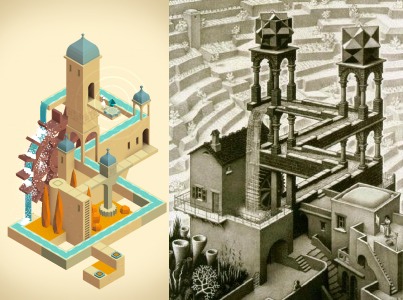We’re spending the month of December looking back at some of the great new releases that we missed out on reviewing earlier this year. This is The Rest of 2014.

Figures walk in a circle up an infinite staircase. A cube comes forward into relief from the page, and at the same time sinks into the background. With the mobile game Monument Valley, British game studio UsTwo has created a unique puzzle game experience, leading players into a labyrinth of architecture that leaves behind perspective and gravity for optical illusions and structural paradoxes.
The player will travel this world as Princess Ida, a simple humanoid cartoon in a dress and pointy hat. Two terse lines of direction start the game, prodding the player into clicking and dragging around on the screen. The first level includes only one scene, wherein a rotatable walkway transforms a structure from a vertical square to a snaking path, introducing the player to the physics that underscore the rest of the game. From that point onward, gameplay is taught intuitively, relying on the player’s ability to recognize patterns and spot the outlying symbols that indicate a button, handle, or other manipulable piece. Player actions trigger melodic cues, building an immersive ambience.
By rotating walkways, the player can connect paths with higher stories. Buttons on the path raise platforms, and draggable blocks ferry the player across gaps or up stories. Ida can travel upside-down or sideways around the monuments. Devices become slowly more complicated as the levels progress, adding layers of dimension-crossing tools to the player’s mental inventory. Sometimes, entire structures can be rotated, revealing reverse sides that must be traversed to obtain access to the goal, or walkways that connect from the shortened perspective of a different angle.

Left: The Halcyon Court level from the Forgotten Shores expansion pack. Right: Waterfall by M.C. Escher.
Anyone familiar with the work of Dutch graphic artist MC Escher will immediately recognize his influence in the courses of Monument Valley. Some chapters of the game include some very direct references to specific prints, but in a more general way, the game seems largely inspired by Escher’s expansion of geometrical illusions like the Penrose triangle into entire worlds of architectural fantasy.
Monument Valley is a beautiful game. The use of color and light build mood, as bright warm colors of outdoor daytime spaces give way to cool moonlit tones of nights, and the dark, limited palette of indoor spaces. In a Behind the Scenes video, UsTwo designer Ken Wong notes the conscious choice to tightly control the composition of scenes: “There was this idea at the start of the project that every screen of the game would be a work of art in itself…every screenshot could be printed out and hung on a wall.” The game un-self-consciously promotes its own beauty with built-in screenshot controls throughout the game, allowing players to pinch in and out to zoom and take photos without button overlays. The camera control tacitly informs players that, in case they hadn’t realized it already, this game is camera-worthy.
The most impressive artistry of Monument Valley, however, like Escher’s printed world, comes from creating plausibility in its structures. The paths and towers must bend the rules of perspective to connect as they do. The structures do not recede into the background as they should to properly show depth. Paths slope gradually, imperceptibly upward, but do so just gradually enough to appear three-dimensionally realistic. Through a careful combination of geometry and stylization, the designers of Monument Valley subtly trick our eyes into accepting the paradoxes of their world with minimal confusion and nausea.
The architecture of this world is not only important as the environment but also as the subject matter for the reflective, melancholic story of Monument Valley. Monument Valley is summarized as “an illusory adventure of impossible architecture and forgiveness.” Not far into the game, Ida encounters ghosts of her past. It is revealed that the game takes place in the ruins of a once-great society, of which Ida is simultaneously the villain and the hero. At the end of each level, where one would expect to find a treasure or perhaps key to unlock the next level, Princess Ida instead pulls off her hat to return from inside a piece of “sacred geometry.” The story is minimally communicated, via snippets of poetic dialogue, chapter titles, cutscenes, and even subtle posing of Ida’s simplistic body broadcasts moments of remorse.
An expansion pack, Monument Valley: Forgotten Shores, takes place at an unspecified point within the timeline of the main storyline. It adds eight extra chapters for Ida to travel in, introducing increased complexity to the gameplay, and adding further pathos to the storyline.
Monument Valley is an art nerd’s delight. It is dedicated to its own artistry and built on taking the fundamentals of two-dimensional art and playfully subverting them. With simple, intuitive gameplay and an immersive world, Monument Valley packs a new and excellent gaming experience into a mobile game that you don’t even need an iPad-sized screen to play. A poignant yet minimal storyline adds momentum to the game yet leaves much up to the interpretation of the player.
Monument Valley is available for Android and iOS.





